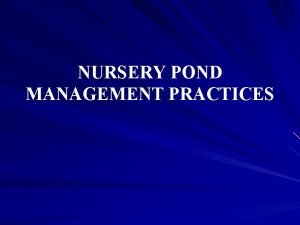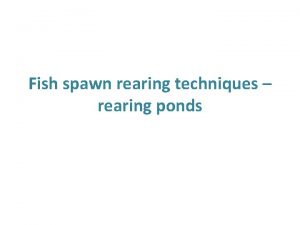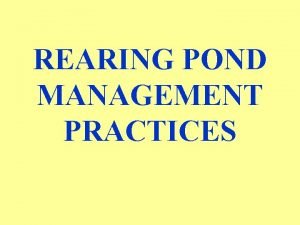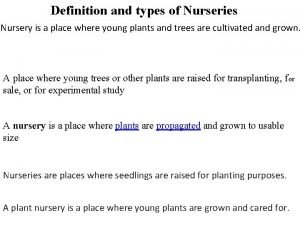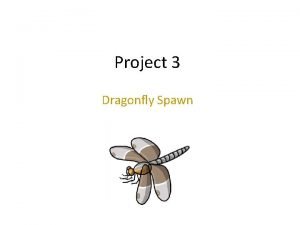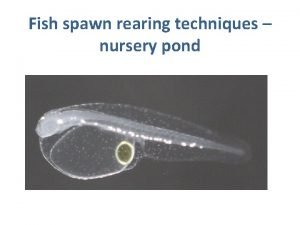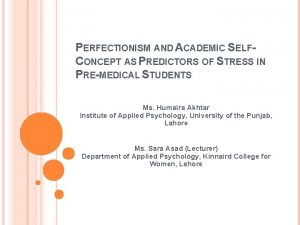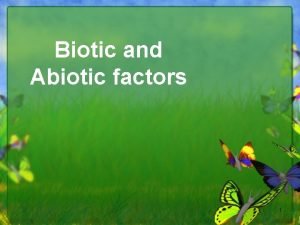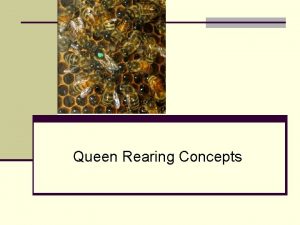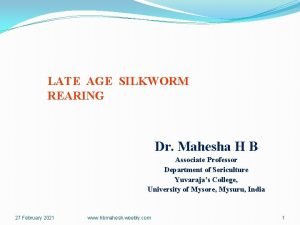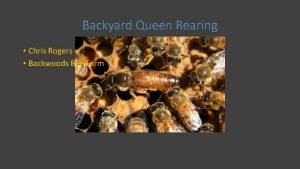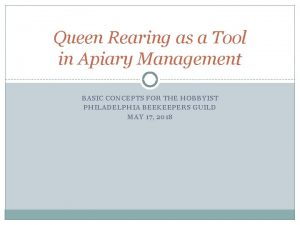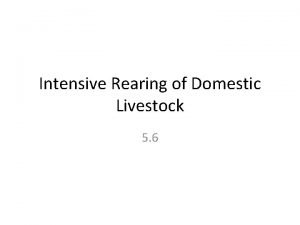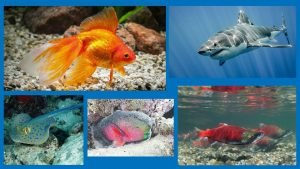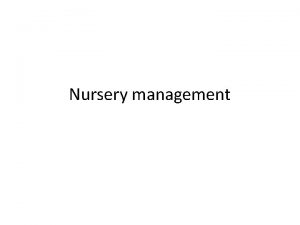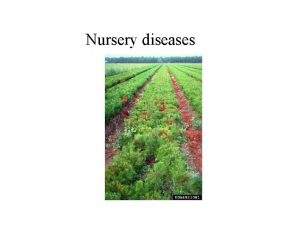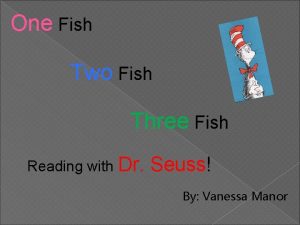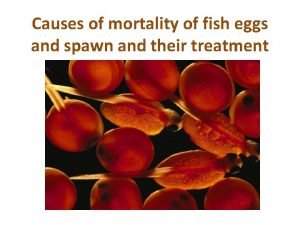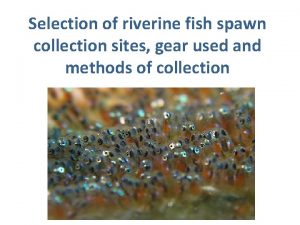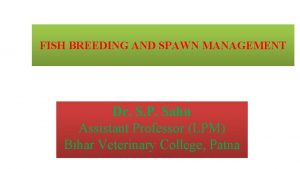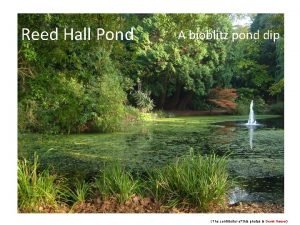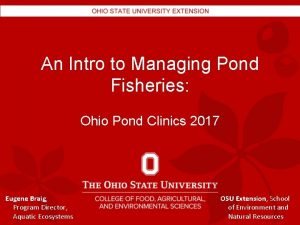Fish spawn rearing techniques nursery pond Three phases


















- Slides: 18

Fish spawn rearing techniques – nursery pond

• Three phases of carp culture (three-tier system) – nursery phase (rearing three-day-old spawn to fry) – rearing phase (rearing fry to fingerling stage) and – grow out phase (rearing fingerlings to adult stage) • Nursery rearing – crucial • According to Alikunhi (1957)- – under Indian conditions a 4 ha farm should be divided into nursery ponds, 0. 2 ha; rearing ponds, 0. 8 ha and stocking ponds, 3 ha – Considering the enhanced rate of stocking and survival of spawn, fry and fingerlings (Barrackpore, 1973) the ratio of nursery to rearing to stock ponds should be 1: 40: 1280

• The occurrence of large scale mortality of stocked spawn – major problem • Average survival of carp fry in nursery ponds does not normally exceed 30% (Basavaraja, 1994), which is attributed to poor nursery practices • The three-day-old spawn normally accept natural or artificial feed and can be transferred to nursery pond where predatory fishes and insects, algal blooms and poor water quality are major causes of mortality

a) Control of predatory and weed fishes • They not only compete with fish for food and space, but also directly prey on them • weed fish - include all species of uneconomic, small-sized fish that naturally occur or are accidentally introduced in ponds along with carp spawn • Weed fishes have high fecundity and mature in summer months and even breed in captivity, in the absence of rains • According to Alikunhi et al. (1952), even the young weed fishes directly feed on carp hatchlings

• Removing unwanted fishes - repeated drag netting • Bottom dwelling fishes (murrels, catfishes and climbing perch) burrow themselves in mud and are difficult to caught • In the worse situation the nursery should be poisoned • Fish toxicants: (i) plant derivatives, (ii) chlorinated hydrocarbons and (iii) organophosphates • Chlorinated hydrocarbons - most toxic to fish; Organophosphates - less toxic to fish

(i) Plant derivatives: • Derris powder, with 5% rotenone content, - most commonly used fish poison • At doses 4 to 20 ppm, most of the fishes, tadpoles and bottom dwelling organisms are killed • The toxicity lasts up to 4 -12 days • The seed powder of Barringtonia acutangula kills a wide variety of fish at 20 ppm, with toxic effect lasting for 48 hrs • Tea seed cake (75 -100 ppm) can be used both as a piscicide and a fertilizer • Mahua oil cake (cake obtained after extracting oil from the seed of the plant, Madhuka latifolia) is widely used to control predatory and weed fishes in Karnataka

• Mahua oil cake (toxic component : saponin, 4 -6%) is used as a fish poison at 200250 ppm, killing fish within 8 hours and the toxicity lasts up to 96 • Later, it acts as a pond fertilizer • Bleaching powder with 30% chlorine content, when applied at 25 -30 ppm, kills all varieties of fishes, including catfishes, murrels, weed fishes and carps • The cost of treatment at 25 -30 ppm is economical as it has the advantage of ready availability at low cost

(ii) Chlorinated hydrocarbons • (a) Aldrin: Aldrin at 0. 2 ppm kills weed fishes and predatory fishes, while 0. 3 ppm aldrin spares zooplankton • (b) Dieldrin : Dieldrin at 0. 01 ppm effectively kills fishes and 0. 5 ppm it kills prawns and insects • (c) Endrin: The most poisonous chemical. Endrin at 0. 001 ppm effectively kills all fishes, prawns and notonectids (iii) Organophosphates • 3 organophosphates, viz. , thiometon, DDVP and phosphamidon have been found effective in killing fish • DDVP at 3 -30 ppm kills most of the unwanted fishes and is recommended for control of trash fishes in nursery ponds

b) Fertilization • To stimulate the production of zooplankton, the most preferred natural food of carp spawn and fry • After liming (200 -400 kg lime per ha, depending upon soil p. H), nursery ponds are treated with either organic manures such as cow dung (10, 000 kg/ha) or poultry manure (5, 000 kg/ha) and a small quantity of inorganic fertilizers (NPK at 200 -400 kg/ha) • Phytoplankton blooms can be controlled by sprinkling liquid cow dung or by covering the surface of the pond with the duck weed, Lemna • The duckweeds are removed after the blooms have been controlled Figure: Application of cow dung as a manure in a carp nursery pond

c) Aquatic insects and their control • In addition to preying directly on carp spawn and fry, also compete with the latter food • The members of the Orders Coleoptera, Hemipitera and Odonata are more important • Among members of the Order Coleoptera, those belonging to the families Dytiscidae, Hydrophilidae and Gyrinidae prey upon fish spawn • Dytiscicids, known as predacious diving beetles, are carnivorous both in adult and larval stages Dytiscidae Hydrophilidae Gyrinidae

• They commonly attack small fish, tadpoles and even dragonfly nymphs • The larvae of Cybister were found to devour 20 advanced fry (24 -40 mm) within 24 hours and can kill even 10 -13 mm carp fingerlings • Among members of the order Hemiptera, the backswimmers, giant water bugs and water scorpions cause a heavy mortality of carp spawn • The back swimmers are highly dangerous, attacking carp spawn, small fish, tadpoles and even small frogs backswimmers giant water bugs water scorpions

• Backswimmers - kill even 10 -13 mm long carp fry, in addition to preying upon plankton, mosquito and chironomid larvae and mayfly nymphs • Water bugs - predaceous and feed on frogs and fishes • Water scorpion and water stick insect attack carp fry and feed on them • Dragonfly (Order: Odonata) nymphs are predatory and feed on carp spawn • They (15 mm long) can swallow 7 carp spawn (6 -7 mm) within 3 hours • The short and long bodied drangonfly nymphs consumed 133 and 125 carp spawn, respectively, in 24 hours Dragonfly

• Predatory aquatic insects multiply rapidly in a nursery pond • To ensure better survival of carp spawn, it is important to effectively clear the pond of its insect population, prior to stocking • Repeated dragging of pond with a fine-meshed net can remove most of the insects • For effective control of insects, insecticides are recommended • Common insecticides affect adversely the zooplankton and fish spawn • Recommended to use only selective poisons which are capable of killing only the insects, but not the spawn and fish food organisms

• Spraying diesel or kerosene on the surface of pond is a well-known and a routine practice in malaria control • The CIFRI’s Substation, Orissa - spraying, on a non-windy day, an emulsion of oil and soap in the ratio of 56: 18 kg/ha • The recommended dose of teepol B-300 which is readily soluble in water and easy to mix with oil, is 560 ml, emulsified with 56 kg of mustard oil • The Department of Fisheries of Maharashtra Government prescribed an emulsion prepared by mixing light speed diesel (1 l), the emulsifier hyoxide 1011 (0. 75 ml) and water (40 ml) for every 200 m 2 water surface

d) Stocking of nursery pond • Nursery pond is stocked with three day old spawn when adequate plankton appears in it • Nurseries with rich crop of zooplankton preferably rotifers and cladoceransmaximum survival of spawn • A minimum of 1. 5 to 2. 0 ml zooplankton in 54. 5 ml water is essential for satisfactory stocking of the pond

• In well manured nurseries 1. 0 -2. 0 million spawn has been stocked with satisfactory results, with a provision of artificial feed, at the pond culture Substation of the CIFRI • Sen (1974) stocked spawn at a high density of 10 million/ha and obtained survival as high as 66. 6% • Later, Tripathi et al. (1979) stocked rohu spawn at an average rate of 10. 21 million/ha and reported an average survival rate of 80. 73%, leading to the production of 8 million fry in a single crop, during 11 -12 days rearing • The stocking of a nursery pond is best done either in the morning or evening hours

e) Supplementary feeding • Stocked spawn feeds on microscopic zooplankton voraciously • A single specimen of live carp spawn (6. 5 -7. 2 mm length) consumes 3 -34 cladocerons within an hour • The common feed - mixture of rice bran and oil cake of ground nut, coconut, mustard, etc. Figure: Harvesting of fry from a nursery pond

• The quantity of artificial feed to be given daily depends upon the weight of the stocked spawn (Alikunhi, 1957; Hora and Pillay, 1962) • Recommended feeding rates - 200, 300 and 400% of the body weight of spawn during the first 5 days, 6 th - 10 th day and 11 th -15 th day after stocking Figure: A haul of carp fry from a nursery pond
 Fish pond management practices
Fish pond management practices Spawn rearing techniques
Spawn rearing techniques One fish two fish red fish blue fish ride
One fish two fish red fish blue fish ride Rearing pond management
Rearing pond management Twofish and blowfish
Twofish and blowfish Characteristics of actinopterygii
Characteristics of actinopterygii Nursery plant definition
Nursery plant definition Asciimator
Asciimator Kerosene townhill
Kerosene townhill Kuaka spawn locations
Kuaka spawn locations Big fish little pond effect
Big fish little pond effect Biotic components of fish pond
Biotic components of fish pond Queen rearing calendar
Queen rearing calendar Shoot rearing
Shoot rearing Queen rearing calendar
Queen rearing calendar Hopkins method of queen rearing
Hopkins method of queen rearing Intensive rearing of livestock
Intensive rearing of livestock Bony vs cartilaginous fish
Bony vs cartilaginous fish Cartilaginous fish features
Cartilaginous fish features
